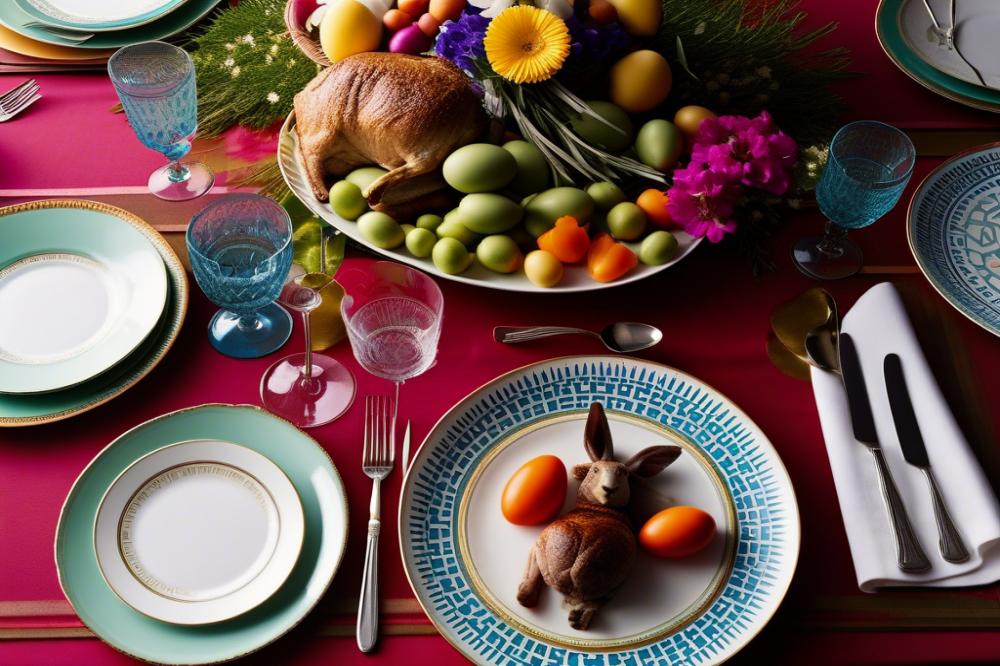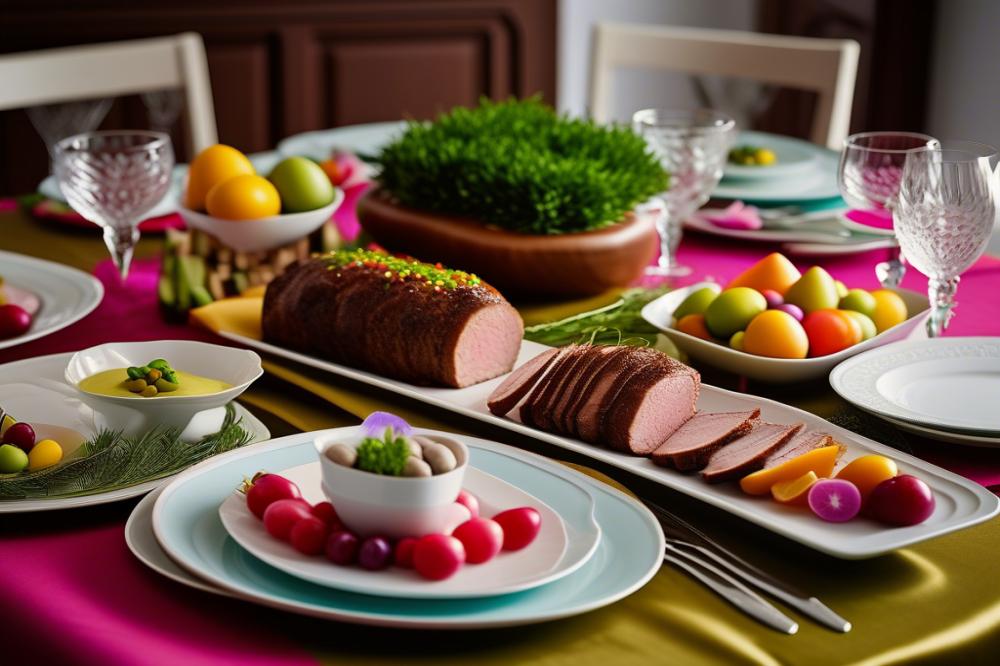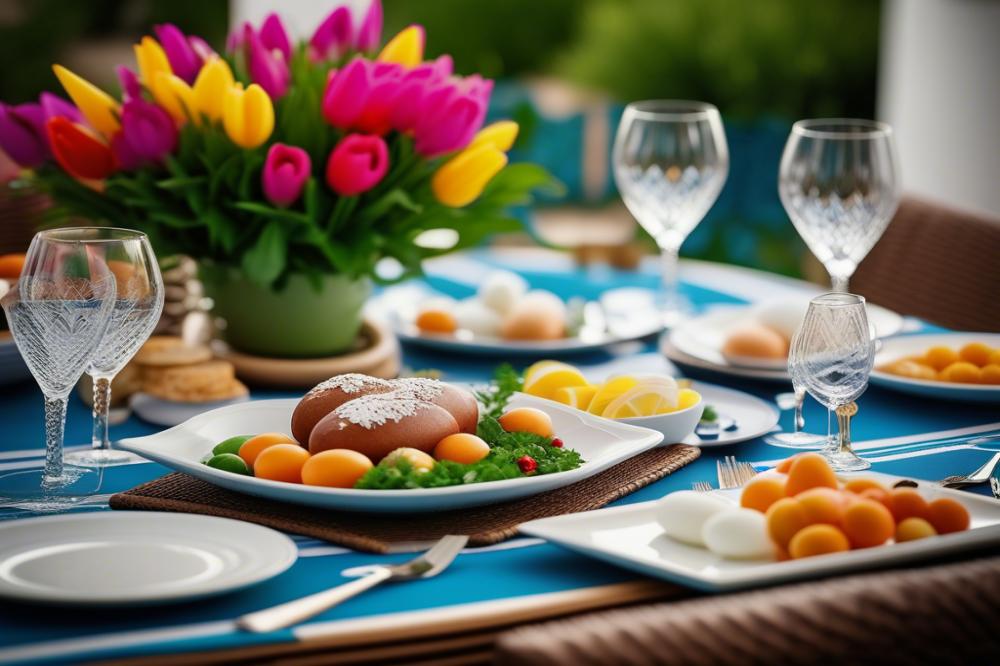Introduction
Greek Easter is more than just a holiday; it is a vibrant cultural and culinary celebration. This time of year brings families together to honor traditions that have been passed down through generations. Food plays a central role in these gatherings, serving as both sustenance and a way to bond with loved ones.
Festive foods are prepared with great care, representing both the spirit of the occasion and the richness of Greek cuisine. traditional dishes such as lamb, magiritsa, and tsoureki fill tables across the country. Each inch of a holiday meal is infused with history and significance. Red-dyed eggs symbolize the blood of Christ, while Easter bread offers a sweet touch to the festivities.
Olive oil, a staple in many Greek families, enhances flavors and adds a touch of authenticity to every dish. Meze, or small plates of various foods, encourages sharing and conversation. As families gather for meals during this festive period, a sense of warmth and togetherness permeates the atmosphere. The culinary journey through these flavors is essential to understanding Greek Easter and its importance in the cultural landscape.
The Significance of Greek Easter

Greek Easter holds immense religious and cultural importance for the people of Greece. It marks the resurrection of Jesus Christ, symbolizing hope and renewal. This celebration lasts for days, filled with rituals that connect the faithful to their heritage. Families gather for services, and communities unite in prayer. Observing traditions is essential during this time, creating a sense of belonging and shared identity.
Numerous customs accompany the festivities. Holy Week leads up to Easter Sunday, beginning with Passion Week. On Holy Saturday, the midnight service is especially notable. People carry candles and await the moment when the priest announces Christ’s resurrection. The joyous response of “Christos Anesti!” can be heard throughout churches and streets. Food plays a significant role in these traditions, serving as a gift to celebrate faith and gather family.
traditional dishes fill tables across the country. Easter isn’t complete without lamb, often roasted over an open fire. This festive food holds deep cultural significance, celebrating abundance and sharing. Red-dyed eggs, a symbol of new life, represent the blood of Christ. Families often tap their eggs together in games to see whose egg will survive unbroken. Magiritsa, a soup made with lamb offal and herbs, is typically enjoyed after the midnight service, comforting those who have fasted.
Another beloved element is tsoureki, a sweet Easter bread woven with flavors of orange and spices. It is often served during family gatherings, bringing loved ones closer. Olive oil is a staple in many dishes, enhancing the flavors of meze served throughout the holiday. These festive foods not only provide nourishment but also reflect a rich culinary heritage.
Sharing meals is an expression of love among families. Preparing food together fosters bonding and connection. The act of gathering around the table creates lasting memories and traditions that are passed down through generations. Food becomes more than sustenance; it is a way to honor beliefs and celebrate life.
Traditional Dishes of Greek Easter

Greek Easter is a time filled with deep-rooted customs and delightful flavors. Many traditional dishes are prepared, each carrying its own significance. A prominent dish during this holiday is magiritsa. This soup, made from lamb offal, rice, and a mix of herbs, symbolizes the end of fasting. Families gather to enjoy this warm dish as they celebrate the resurrection.
The centerpiece of many festive meals is lamb. Roasted to perfection, it represents sacrifice and renewal. Often, this succulent meat is seasoned with herbs and served with seasonal vegetables. It is a dish that brings everyone to the table, creating a shared moment of joy. Lamb is not just a meal; it stands for rich traditions and family bonds.
Also featured at the dining table are bright red-dyed eggs. These eggs symbolize new life. During family gatherings, it’s common for children and adults alike to engage in the friendly game of cracking their eggs against one another. This is not just fun; it reflects resilience and the spirit of Easter.
Festive Foods and Seasonal Ingredients
Other beloved foods include tsoureki, a sweet, braided bread. Its soft texture and aromatic flavors make it a favorite during the holiday. This Easter bread often contains spices like mahleb and orange zest, offering a hint of sweetness that complements the savory dishes. It is usually enjoyed with coffee or tea, making it a perfect addition to the Easter feast.
Fresh ingredients play a significant role in these dishes. Olive oil is used generously, imparting richness to everything it touches. Herbs like dill and parsley add brightness, elevating the overall flavor profile of the meal. Many side dishes, or meze, also showcase seasonal produce, creating a beautiful display on the table.
As families sit down to eat, the festive foods symbolize unity and celebration. The dishes of Greek Easter not only satisfy hunger but also tell stories of heritage and love. Each bite carries memories of past gatherings and hopes for the future. The flavors of the season come together in harmony, making the holiday truly special.
Festive Foods and Treats

During the Easter season, families in Greece prepare an array of festive foods that embody tradition and cultural significance. Each dish carries its own story and significance, making the celebrations even more special. Among these, the spotlight often shines on tsoureki, a rich and slightly sweet bread that symbolizes the resurrection. This Easter bread is often braided and sometimes flavored with spices like orange and mahleb, creating a delightful aroma in homes across the country.
Another highlight is the beloved red-dyed eggs. These vibrant eggs represent the blood of Christ and the renewal of life. Families often dye eggs together, making it a cherished activity that brings everyone closer. On Easter Sunday, a game called “tsougrisma” is played with these eggs, adding an element of fun and competition to the holiday.
In addition to bread and eggs, meze plays an important role during family gatherings. These small dishes are served as appetizers and create a warm atmosphere for sharing and conversation. Traditional items could include olives drizzled in olive oil, feta cheese, and various dips, all of which tantalize the taste buds.
Magiritsa, a rich soup made with lamb, is also popular. It is often prepared on Holy Saturday and served after midnight. This special dish warms hearts and bellies alike. Ultimately, the combination of these festive foods creates a unique experience that is deeply rooted in Greek traditions.
Easter Sunday Feast

Easter Sunday in Greece is a day filled with joy and celebration. Families come together to enjoy a grand feast that symbolizes the end of Lent. Special dishes are prepared to honor this important holiday. The atmosphere is lively and warm, as loved ones gather around the table.
At the center of the meal is the lamb, which is often roasted over an open fire. This cooking method adds a distinct flavor that is cherished by many. Alongside the lamb, people serve traditional dishes like magiritsa, a soup made from lamb offal, flavored with herbs and served as a symbol of the Resurrection. Its rich taste connects the family to their roots.
Festive foods play a key role in the Easter Sunday celebration. Tsoureki, a sweet Easter bread, is often enjoyed for its delicious taste and beautiful braided shape. Red-dyed eggs are also a common sight. They symbolize the blood of Christ and the rebirth of spring. Families engage in a playful tradition known as “tsougrisma,” where they try to crack each other’s eggs. This lively interaction adds to the festivities.
Meze, or small dishes served with olive oil and dips, also grace the table. This encourages sharing and conversation among guests. Families often prepare these dishes together, reinforcing the bond between generations. Each recipe shared has a story behind it and is passed down through the years.
During the meal, laughter and chatter fill the air. People share stories, jokes, and memories. The spirit of community is strong during this feast, reminding everyone of what truly matters. Togetherness is celebrated, and the importance of family gatherings shines through with each bite.
This Easter Sunday feast is more than just food. It is a time for connection, joy, and gratitude. The flavors of Greece create a memorable experience that stays in the heart long after the last plate is cleared.
Culinary Experiences and Travel Tips
Embarking on a culinary journey during Easter in Greece offers a taste of tradition. To truly embrace this vibrant celebration, consider traveling to regional hotspots. Many islands and towns host unique events that highlight their local customs. Visiting places like Corfu or Crete can immerse you in Easter festivities.
Recommendations for Local Markets and Authentic Restaurants
Start your culinary adventure in local markets. Fresh produce, meats, and dairy are abundant. Look for stalls with old-world charm. Here, vendors often share recipes for traditional dishes. Highlight seasonal items such as lamb, which is a centerpiece of Easter feasts. You can also find red-dyed eggs and festive foods that are popular during this time.
Don’t forget to explore the small eateries. Authentic restaurants often serve classic dishes like magiritsa, a rich soup made with lamb and greens. Many also offer tsoureki, a sweet Easter bread, drizzled with olive oil. Try to converse with the owners; they might share personal stories that enhance your experience. Meals typically include meze, which are small plates perfect for sharing during family gatherings.
Tips for Participating in Easter Celebrations with Locals
Engaging in local traditions can deepen your understanding of this cultural event. Attend a midnight service on Holy Saturday for a real treat. The atmosphere is electric with anticipation, where the community gathers with candles in hand. You’ll witness how families celebrate after the spiritual services, often gathering for meals after a long fast.
Joining local festivities is another way to connect. Participate in activities like dyeing eggs or tasting traditional Easter dishes with residents. People enjoy sharing their customs, and many locals appreciate visitors who show interest. Always be open to learning and experiencing their way of celebrating.
By partaking in these experiences, you not only enjoy delicious food but also build connections with the culture. Make sure to take photos and savor the history behind each dish you try. Such moments will become cherished memories of your travels.
A Culinary Journey’s End
This exploration of flavors and customs surrounding Greek Easter offers a rich tapestry of traditions. Aromas of roasted lamb, the sweetness of tsoureki, and the bold flavors of various mezes evoke a sense of togetherness. Each dish carries a story, steeped in history and cultural significance. Gathering around the dinner table transforms meals into cherished memories.
As the festive occasion approaches, consider diving into this vibrant culinary culture. Preparing traditional dishes at home can connect you with the spirit of the holiday. Whether it involves baking a loaf of tsoureki or crafting colorful eggs, you become part of something larger. Such activities can foster relationships, spark conversations, and create bonds with family and friends. Sharing meals is a universal language, one that transcends generations.
The essence of Greek Easter lies not only in flavors but also in the warmth of shared experiences. Celebrating the holiday with loved ones enhances the enjoyment. Savoring each bite while surrounded by good company creates unforgettable moments. Remember, food is more than fuel; it is a bridge linking hearts and cultures. Take time to appreciate each dish and the love that goes into making it.
May this festive season inspire you to explore and indulge in the delights of Greek culinary culture. The beauty of holiday traditions is that they invite everyone to partake. Engaging with these practices can broaden your understanding of a rich heritage. So, embrace this opportunity to discover and enjoy the flavors of this special time.



